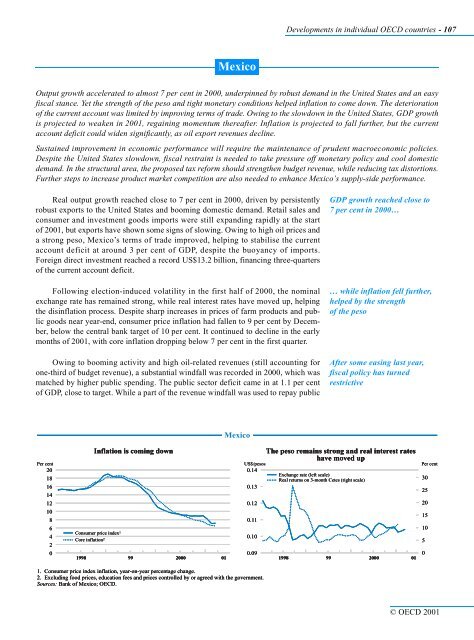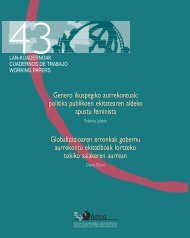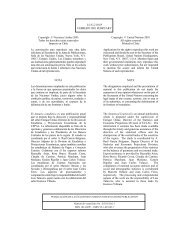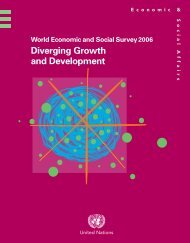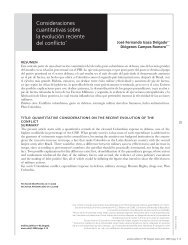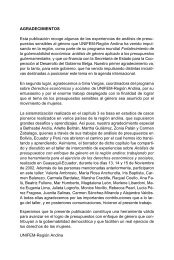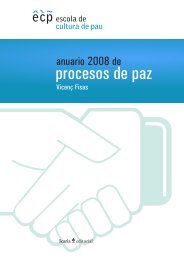OECD Economic Outlook 69 - Biblioteca Hegoa
OECD Economic Outlook 69 - Biblioteca Hegoa
OECD Economic Outlook 69 - Biblioteca Hegoa
Create successful ePaper yourself
Turn your PDF publications into a flip-book with our unique Google optimized e-Paper software.
Mexico<br />
Developments in individual <strong>OECD</strong> countries - 107<br />
Output growth accelerated to almost 7 per cent in 2000, underpinned by robust demand in the United States and an easy<br />
fiscal stance. Yet the strength of the peso and tight monetary conditions helped inflation to come down. The deterioration<br />
of the current account was limited by improving terms of trade. Owing to the slowdown in the United States, GDP growth<br />
is projected to weaken in 2001, regaining momentum thereafter. Inflation is projected to fall further, but the current<br />
account deficit could widen significantly, as oil export revenues decline.<br />
Sustained improvement in economic performance will require the maintenance of prudent macroeconomic policies.<br />
Despite the United States slowdown, fiscal restraint is needed to take pressure off monetary policy and cool domestic<br />
demand. In the structural area, the proposed tax reform should strengthen budget revenue, while reducing tax distortions.<br />
Further steps to increase product market competition are also needed to enhance Mexico’s supply-side performance.<br />
Real output growth reached close to 7 per cent in 2000, driven by persistently<br />
robust exports to the United States and booming domestic demand. Retail sales and<br />
consumer and investment goods imports were still expanding rapidly at the start<br />
of 2001, but exports have shown some signs of slowing. Owing to high oil prices and<br />
a strong peso, Mexico’s terms of trade improved, helping to stabilise the current<br />
account deficit at around 3 per cent of GDP, despite the buoyancy of imports.<br />
Foreign direct investment reached a record US$13.2 billion, financing three-quarters<br />
of the current account deficit.<br />
Following election-induced volatility in the first half of 2000, the nominal<br />
exchange rate has remained strong, while real interest rates have moved up, helping<br />
the disinflation process. Despite sharp increases in prices of farm products and public<br />
goods near year-end, consumer price inflation had fallen to 9 per cent by December,<br />
below the central bank target of 10 per cent. It continued to decline in the early<br />
months of 2001, with core inflation dropping below 7 per cent in the first quarter.<br />
Owing to booming activity and high oil-related revenues (still accounting for<br />
one-third of budget revenue), a substantial windfall was recorded in 2000, which was<br />
matched by higher public spending. The public sector deficit came in at 1.1 per cent<br />
of GDP, close to target. While a part of the revenue windfall was used to repay public<br />
Mexico<br />
GDP growth reached close to<br />
7 per cent in 2000…<br />
… while inflation fell further,<br />
helped by the strength<br />
of the peso<br />
After some easing last year,<br />
fiscal policy has turned<br />
restrictive<br />
Inflation is coming down<br />
The peso remains strong and real interest rates<br />
have moved up<br />
Per cent US$/pesos Per cent<br />
20<br />
18<br />
0.14<br />
30<br />
16<br />
14<br />
0.13<br />
25<br />
12<br />
0.12<br />
20<br />
10<br />
8<br />
0.11<br />
15<br />
6<br />
4<br />
2<br />
Consumer price index<br />
0.10<br />
10<br />
5<br />
0<br />
1998 99 2000 01<br />
0.09<br />
1998 99 2000 01<br />
0<br />
1<br />
Core inflation2 Inflation is coming down<br />
The peso remains strong and real interest rates<br />
have moved up<br />
Per cent US$/pesos Per cent<br />
20<br />
18<br />
0.14<br />
Exchange rate (left scale)<br />
Real returns on 3-month Cetes (right scale)<br />
30<br />
16<br />
14<br />
0.13<br />
25<br />
12<br />
0.12<br />
20<br />
10<br />
8<br />
0.11<br />
15<br />
6<br />
4<br />
2<br />
Consumer price index<br />
0.10<br />
10<br />
5<br />
0<br />
1998 99 2000 01<br />
0.09<br />
1998 99 2000 01<br />
0<br />
1<br />
Core inflation2 Inflation is coming down<br />
The peso remains strong and real interest rates<br />
have moved up<br />
Per cent US$/pesos Per cent<br />
20<br />
18<br />
0.14<br />
Exchange rate (left scale)<br />
Real returns on 3-month Cetes (right scale)<br />
30<br />
16<br />
14<br />
0.13<br />
25<br />
12<br />
0.12<br />
20<br />
10<br />
8<br />
0.11<br />
15<br />
6<br />
4<br />
2<br />
Consumer price index<br />
0.10<br />
10<br />
5<br />
0<br />
1998 99 2000 01<br />
0.09<br />
1998 99 2000 01<br />
0<br />
1<br />
Core inflation2 Exchange rate (left scale)<br />
Real returns on 3-month Cetes (right scale)<br />
1. Consumer price index inflation, year-on-year percentage change.<br />
2. Excluding food prices, education fees and prices controlled by or agreed with the government.<br />
Sources: Bank of Mexico; <strong>OECD</strong>.<br />
© <strong>OECD</strong> 2001


